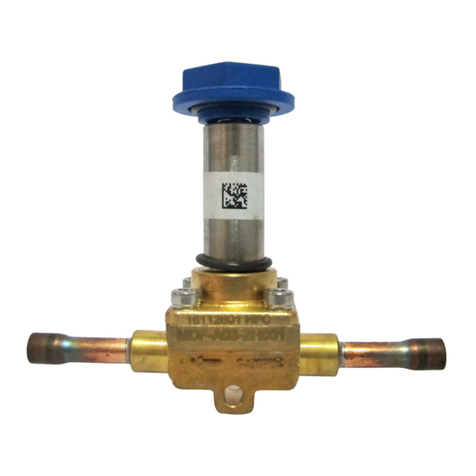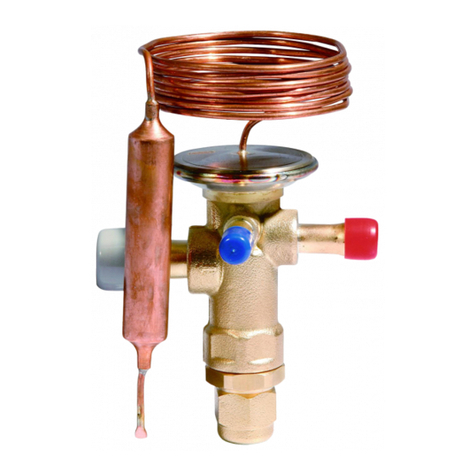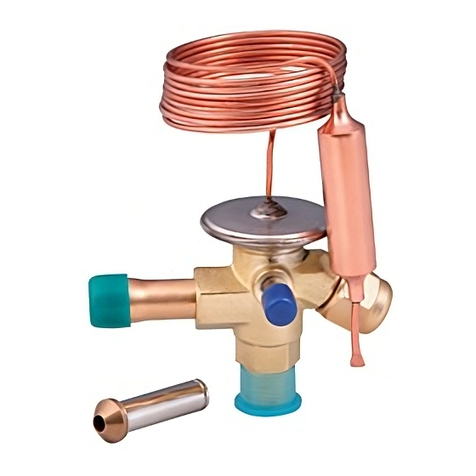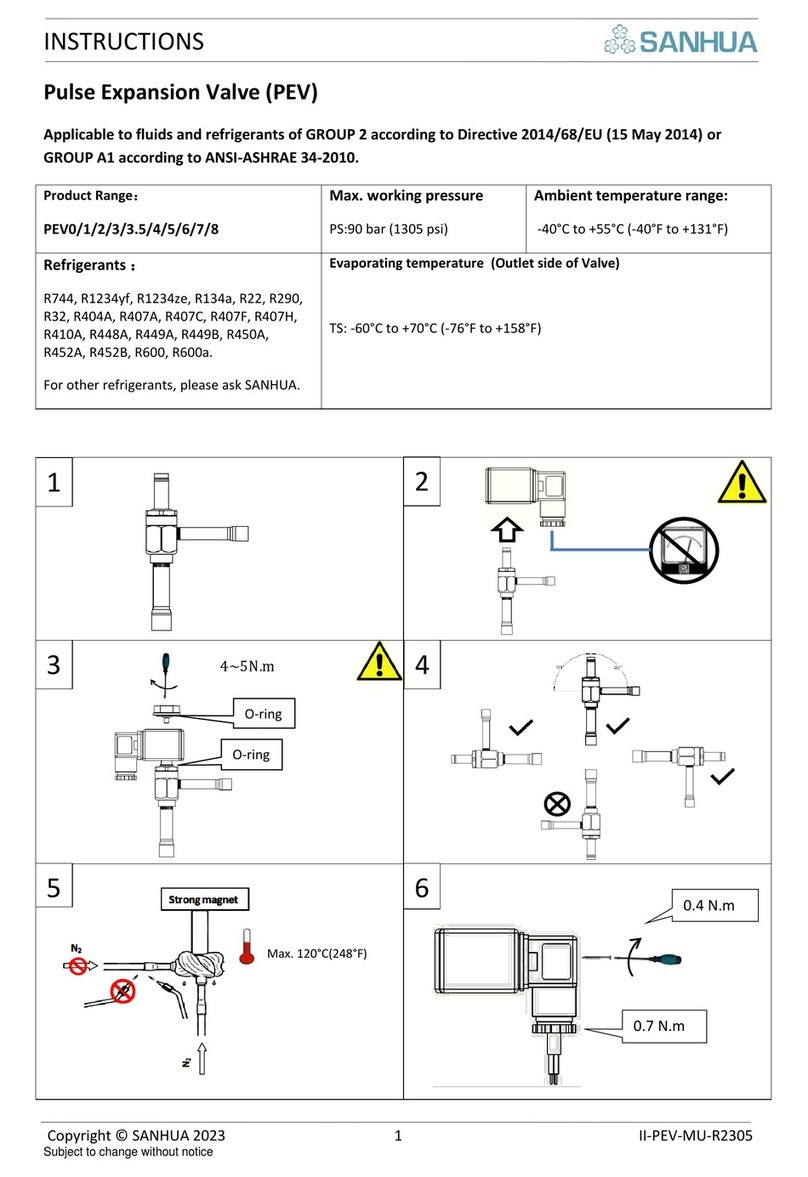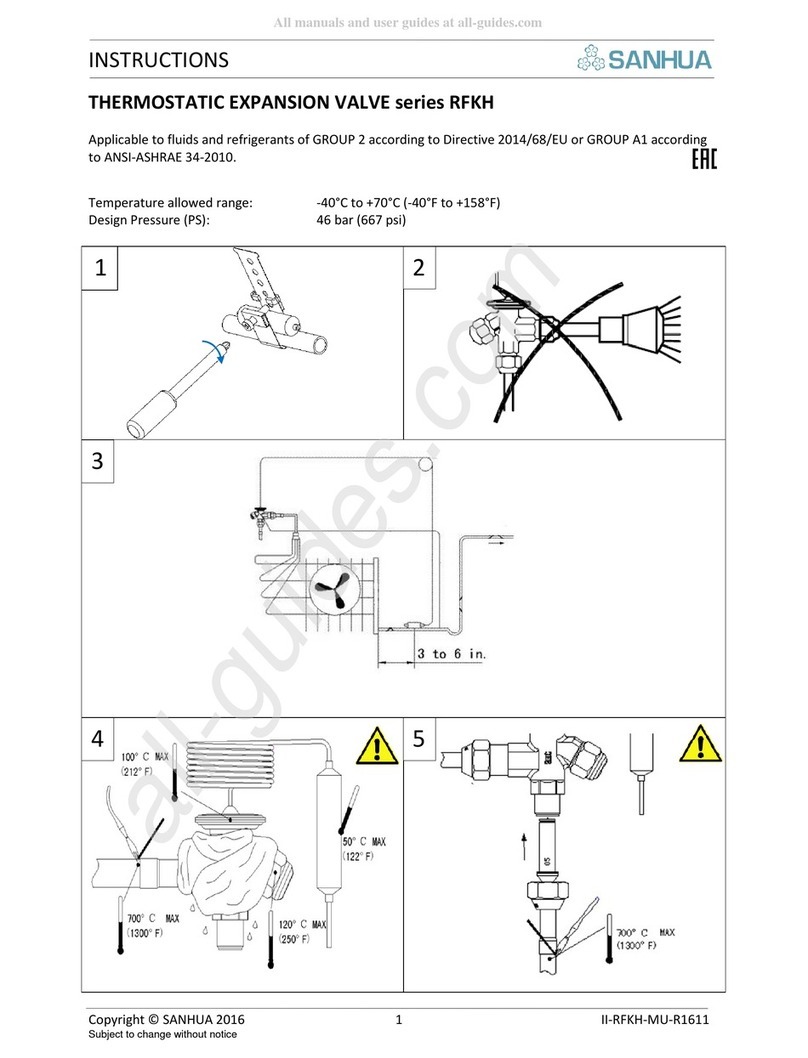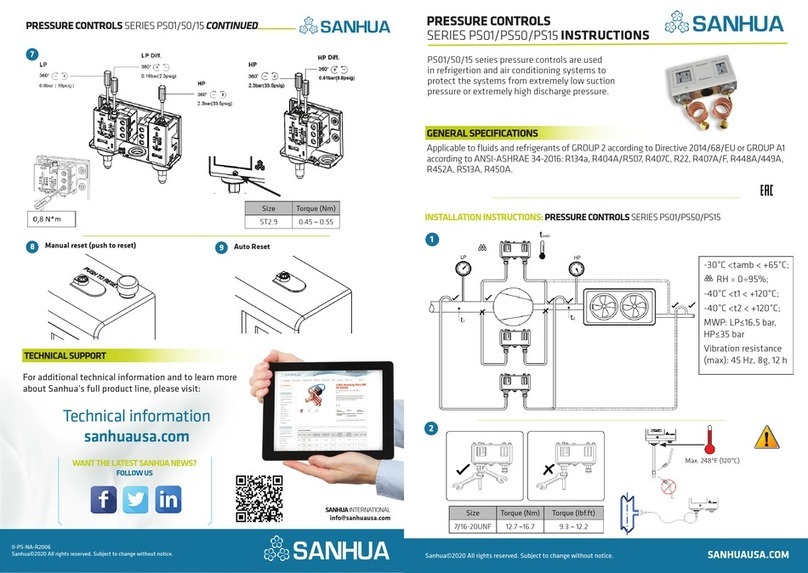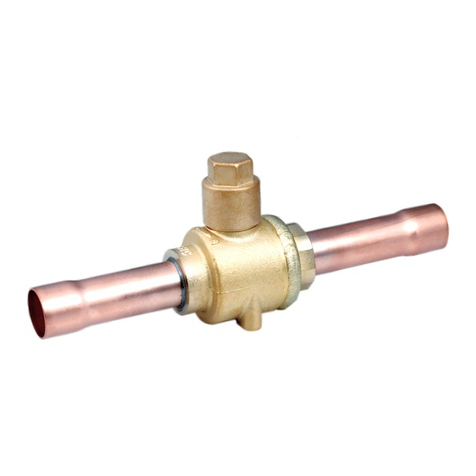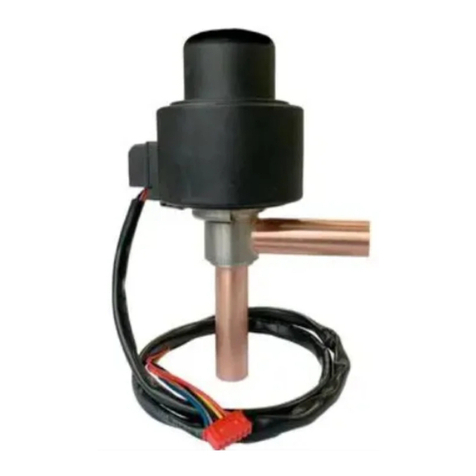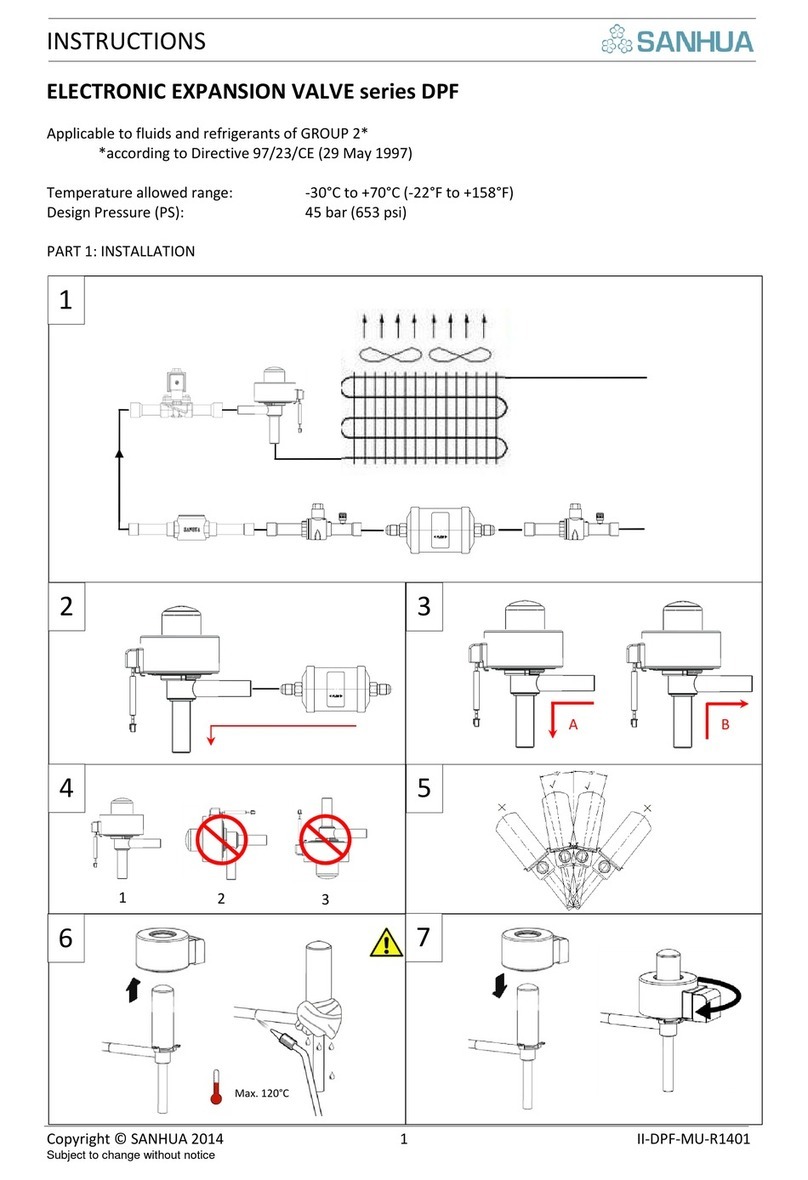
INSTRUCTIONS
Copyright © SANHUA 2021 3 II-DPF-R-EN-R2101
Subject to change without notice
prohibited
installation with
stator pointed
downwards (pos.2
and 3).
permis d’installer le
détendeur « tête en bas »
comme la pos.2 et pos.3
darf nicht kopfüber
eingebaut werden
(Pos. 2 und 3).
(pos.1). E’
proibital’installazion
e con lo
statorerivolto verso
il basso (pos.2 e 3).
Estáprohibida la
instalación con el
estatorvueltohaciaa
bajo (pos.2 y 3)
Поз. 2 и 3 со
статором вниз
недопустимы.
It is admitted a
tolerance of ±15° for
the coil as regards
the vertical axis, as
shown in the
picture.
Il est autorisé une
inclinaison de +/- 15° de
l’axe de la bobine par
rapport à la verticale
comme montré sur le
schéma.
Die Ventilachse darf
um ±15° gegen die
Vertikale geneigt sein,
wie im Bild gezeigt.
E’ ammessa una
tolleranza di ±15°
dellabobina rispetto
all’asseverticale,
come mostrato in
figura.
Se admite una
tolerancia del ±15°
de la bobinarespecto
al eje vertical, como
se muestra en la
figura.
Допускается
отклонение оси
катушки от
вертикали не более
±15°.
Before the brazing
process, remove the
coil if it is just
installed on the
valve body. Braze
the two valve
connections using
specific alloy (SilFos
15). Use a wet rag
on the valve during
the brazing process
Avant le brasage, retirer
la bobine si celle-ci est
présente. Braser les tubes
en utilisant un alliage
spécifique (type SilFos
15). Placer un chiffon
mouillé sur le corps du
détendeur pendant le
brasage.
Vor dem Einlöten die
Spule vom Ventilkörper
abnehmen. Einlöten
des Ventils unter
Verwendung spezieller
Legierung (SilFos 15).
Während des
Lötvorgangs das Ventil
mitnassemLappenumw
ickeln.
Prima del processo
di
brasaturarimuovere
la bobina se
giàinstallatasulcorpo
valvola. Brasare le
due
connessionidellavalv
olausando una
legaspecifica (SilFos
15).
Usareunostracciobag
natosullavalvoladura
nteilprocesso di
brasatura.
Antes del proceso de
soldaduraquitar la
bobinasiestáinstalad
a en el cuerpo de la
válvula. Soldar las
dos conexiones de la
válvulausando una
aleaciónespecífica
(SilFos 15). Usar un
pañohúmedosobre
la válvuladurante el
proceso de
soldadura.
Перед установкой
вентиля снимите
катушку. При пайке
патрубков
пользуйтесь
припоем (SilFos 15).
Защитите вентиль
от перегрева
мокрой ветошью.
在焊接前移
除线圈,采
用特殊合金
(推荐 SilFos
15) 焊 接 过
程中使用湿
布覆盖阀体
上
Install the coil on the
valve body. Turn the
coil to fix it
correctly.
Installer la bobine sur le
corps du détendeur.
Tourner la bobine
jusqu’au point d’accroche
pour la fixer
correctement sur le
détendeur.
Die Spule auf den
Ventilkörper
aufstecken. Zur
Fixierung die Spule
drehen.
Installare la
bobinasulcorpovalvo
la. Ruotare la bobina
per
fissarlacorrettament
e.
Instalar la
bobinasobre el
cuerpo de la válvula.
Girar la bobina para
fijarlacorrectamente
.
Установитекатушку
навентиль.
Зафиксируйте
катушку, повернув
ее как указано на
рисунке.
The coil connector
presents 5 wires:
cables COM( grey )
must be connected
to the positive pole.
The coil rated
voltage is DC12V ±
10%
La bobine possède 5 fils :
le fil COM (gris) doit être
connecté au pôle positif.
La tension d’alimentation
de la bobine est 12VDC±
10%
Der Spulenstecker hat
5 Drähte: Die Kabel
COM (grau) müssen an
den Pluspol
angeschlossen werden.
Die Nennspannung der
Spule beträgt DC12V ±
10%
Il connettoredella
bobina presenta 5
fili: i cavi COM
(grigio)
devonoesserecollega
ti al polo positivo.
La tensione
nominale della
bobina è DC12V ±
10%
El conector de la
bobina presenta 5
cables: los cables
COM (gris) deben
conectarse al polo
positivo.
La tensión nominal
de la bobina es
DC12V ± 10%
Подключение
катушки через 5
проводов: провод
СОМ (общий,
серый) должен
быть постоянно
подключен («+»).
Питание катушки
12 В постоянного
тока ± 10%
线圈有 5根
引线:引线
COM( 灰色)
必须连接正
极 , 线 圈 额
定 电 压 为
DC12V± 10%
Give 0 pulse to
adjust the starting
point. When the
valve is completely
close re-set the
starting point to Ø1
phase excitation
using the following
method:
Keep the coil de-
energized, then
energize it and
charge 560 pulses to
close valve.
During control
process: current
open position plus 8
pulse in closing
direction.
Paramétrer 0 pulse pour
ajuster le point de départ.
Lorsque le détendeur est
complètement fermé, re-
paramétrer le point de
départ avec la phase
d’excitation Ø1en
utilisant la méthode
suivante : Gardez la
bobine non alimentée,
ensuite alimentez la et
appliquez 560 pulses
pour fermer le
détendeur.
Pendant le process de
contrôle : Rajoutez 8
pulses pour fermer le
détendeur.
0 Puls aufgeben zum
Justieren des
Startwertes. Wenn das
Ventil ganz geschlossen
ist, den Startwert zu
Ø1 Phasenansteuerung
zurücksetzen unter
Verwendung folgender
Methode: Die Spule
stromlos lassen, dann
bestromen und 560
Pulse zum Schliessen
aufgeben. Während
des Regelprozesses:
Aktuelle
Öffnungsposition plus
8 Pulse in
Schließrichtung
aufgeben.
Dare 0 impulsi per
regolare il punto di
partenza. Quando la
valvola è
completamente
chiusa resettare il
punto di partenza
alla fase di
eccitazione Ø1
usando il seguente
metodo: Tenere la
bobina diseccitata,
quindi eccitarla e
caricarla di 560
impulsi per chiudere
la valvola. Durante
ilprocesso di
controllo:
Pulsar 0 para ajustar
el punto de
arranque. Cuando la
válvulaestácompleta
-
mentecerradaresete
ar el punto de
arranque a la fase de
excitación Ø1
usando el
siguientemétodo:
Tener la
bobinadesconectada
, luegodarlecorriente
y cargarla a 560
pulsos para cerrar la
válvula. Durante el
proceso de control
Подайте 0 импульс
для для установки
начальной
позиции. При
полностью
закрытом вентиле
переустановите
начальную точку на
Ø1 фазу
следующим
образом:
подключите
питание к
обесточенной
катушке и подайте
560 импульсов для
закрытия вентиля.
При перенастройке
подайте 8
импульсов для
закрытия вентиля.
调节初始位
置在 0脉冲
下。当阀完
全关死的时
候,根据以
下原理 Ø1
相励磁,重
新设置初始
位置:开始
线 圈 不 通
电,之后通
560 个 脉 冲
将阀关死。
控 制 过 程
中:在阀关
到0脉冲时
再额外通 8
个脉冲关闭
操作
To open the valve
use excitation steps
(table 1) from
position 1 to
position 8
Pour ouvrir le détendeur,
utiliser la table
d’excitation 1 (table 1) de
la position 1 à 8
Zum Öffnen des Ventils
die
Ansteuerungsschritte
(Tab.1) von Pos. 1 nach
Pos. 8 aufgeben.
Per aprire la
valvolausaregliimpul
si di eccitazione
(tabella 1)
dallaposizione 1
allaposizione 8
Para abrir la
válvulausar los
pulsos de excitación
(tabla 1) de la
posición 1 a la 8.
Для открытия
вентиля
используете
импульсы (табл. 1)
от позиции 1 до
позиции 8.
To close the valve
use excitation steps
(table 1) from
position 8 to
position 1
Pour fermer le
détendeur, utiliser la
table d’excitation 1 (table
1) de la position 8 à 1
Zum Schließen des
Ventils die
Ansteuerungsschritte
(Tab.1) von Pos. 8 nach
Pos. 1 aufgeben.
Per chiudere la
valvolausaregliimpul
si di eccitazione
(tabella 1)
dallaposizione 8
allaposizione 1
Para cerrar la
válvulausar los
pulsos de excitación
(tabla 1) de la
posición 8 a la 1.
Для закрытия
вентиля
используете
импульсы (табл. 1)
от позиции 8 до
позиции 1.
Stepping motor with
permanent magnets
has self-
maintenance, and it
doesn’t need
Le moteur pas à pas avec
aimants permanents à un
phénomène d’auto
maintien et n’a donc pas
besoin d’être alimenté
Der Schrittmotor mit
Permanentmagnet hat
eine Selbst-Haltung
und benötigt keine
Bestromung zum
Il motorepassopasso
con
magnetipermanenti
ha una funzione di
auto mantenimento,
El motor de pasos
con
imánpermanentetie
ne una función de
automanteni-miento
Шаговый
элекродвигатель с
постоянным
магнитом
самофиксируется и
